what to do if another motorcycle want to pass while land splitting
10 Things to Know About Lane Splitting in California (No. 1? Yes, Information technology'south Legal)
Failed to salve article
Please try again
Update: On Sept. 27, 2018, the California Highway Patrol released its "Lane Splitting Safety Tips," 2 years later a new state law instructed the bureau — along with other stakeholders — to develop guidelines.
If you've ever driven in California, you've probably had a motorbike bulldoze between you and another car.
This is chosen lane splitting (also known every bit lane sharing or filtering), and a 2014 report establish that eighty percentage of California motorcyclists lane split on the freeway, with more than half saying they do it "often" or "always."
People have a lot of feelings about it, just they don't ever accept all the information. So hither are 10 things y'all need to know to understand lane splitting in California.
1. It'southward legal
One of the biggest misconceptions is that when motorcyclists are lane splitting, they are breaking the law. They're not.
"The practise of lane splitting or lane sharing has never been prohibited by California law," said Sgt. Larry Starkey, who runs the California Highway Patrol's California Motorcyclist Prophylactic Program. "So therefore information technology's always been an acceptable practice."
Co-ordinate to the 2014 study, only 60.vii percent of vehicle drivers knew that lane splitting was legal.
Motorcyclists who are lane splitting even so have to obey speed limits and other rules of the road, and can be ticketed if they don't lane split responsibly.
2. A new police force changed things ... sort of
In 2016, Gov. Jerry Brown signed AB 51 into constabulary, which defined lane splitting as "driving a motorcycle ... that has two wheels in contact with the footing, between rows of stopped or moving vehicles in the same lane, including on both divided and undivided streets, roads, or highways."
Co-ordinate to the CHP, this didn't really change country law. What information technology did was requite CHP the power to develop guidelines around lane splitting.
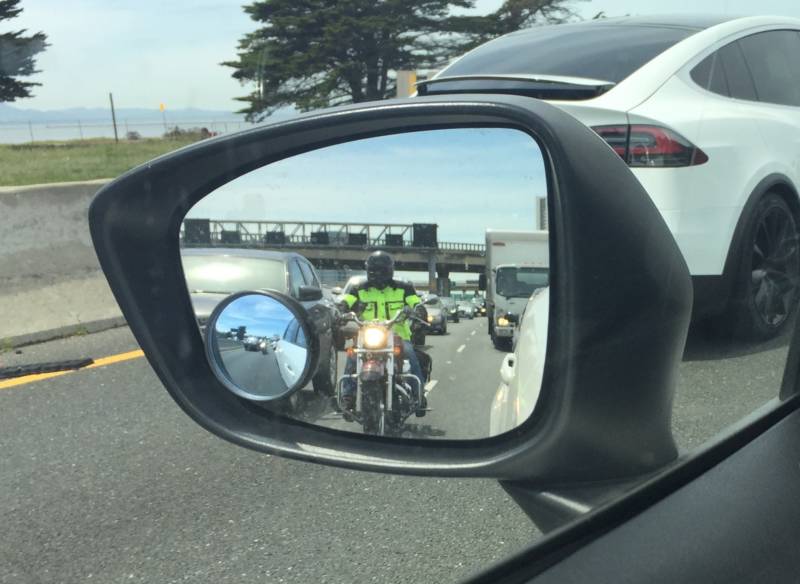
This was of import because the CHP put up lane splitting guidelines in 2013, simply took them downwardly a year afterwards subsequently a complaint was made to the state's Function of Authoritative Law. The guidelines could be seen as CHP establishing a new constabulary.
AB 51 officially gave CHP the power to create those guidelines. Starkey said that after the constabulary took consequence on Jan. one, 2017, the CHP worked with Section of Transportation, Department of Motor Vehicles, Office of Traffic Rubber and motorcycle rubber organizations to create new guidelines, which were released in September 2018.
The "Lane Splitting Safety Tips" brainstorm with disclaimer that, "Lane splitting can be unsafe and extreme caution should exist exercised. Information technology should not be performed by inexperienced riders." They include tips for motorcyclists (be aware of your environment, avoid lane splitting betwixt large vehicles, danger increases at higher speeds and speed differentials) as well as messages for other vehicle drivers (lane splitting is legal, intentionally blocking a lane splitter is not).
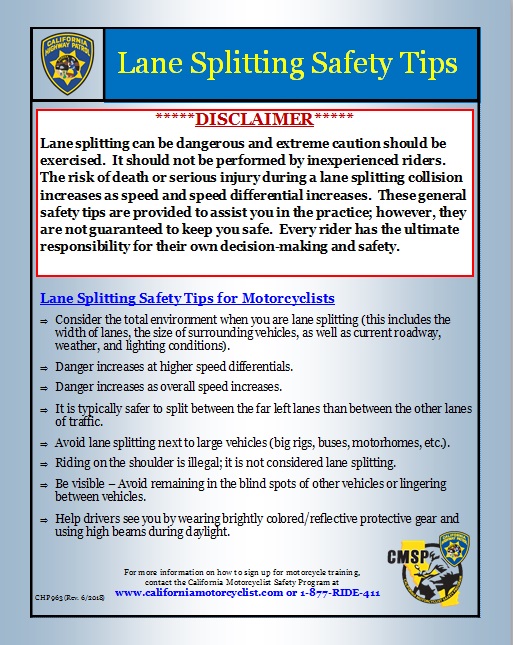
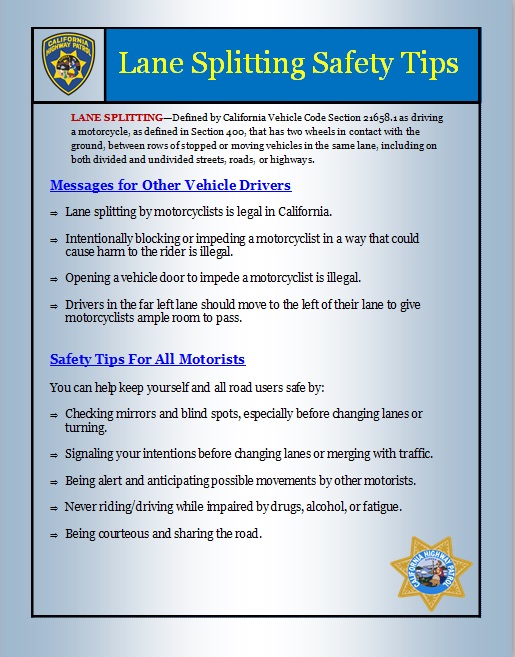
3. It's legal only in California
According to the American Motorcyclist Association'due south website, every state except California bans the practice of lane splitting. Specifically, united states prohibit motorcycles from passing a vehicle in the same lane and riding betwixt lanes of traffic or rows of vehicles.
four. Other states are trying to legalize it
At to the lowest degree nine other states accept considered legislation that would allow lane splitting, and some are expected to take upwardly the issue once more in the next legislative session, co-ordinate to Nick Haris, the Western states representative for the American Motorcyclist Association.
"I think as a nation, as nosotros meet traffic and attempts to address issues with gridlock, I think this is but going to be ane of those things that'due south identified equally a good way to get," Haris said of the increased interest in legalizing lane splitting.
5. It's legal in lots of other countries
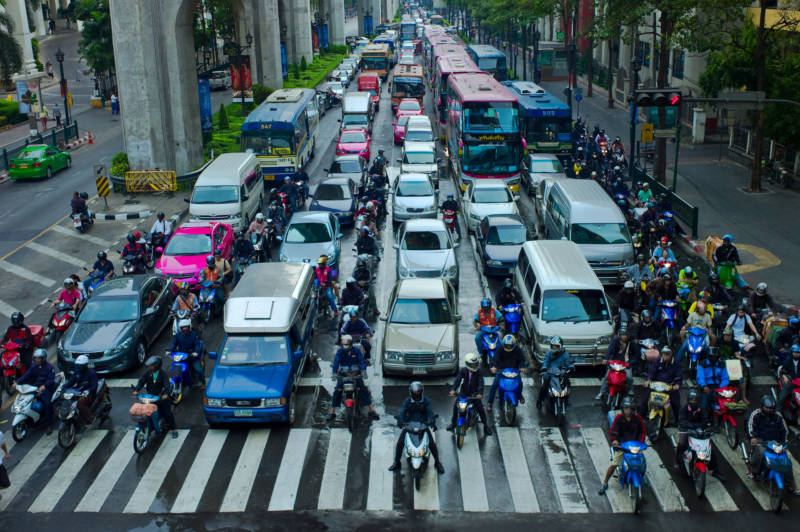
Lane splitting is legal and widespread in many European and Asian countries.
"It really is a style of life in Europe," said Emma Booton, who grew up in England and has been riding motorcycles for 41 years.
"I've ridden in New Zealand where everybody just basically waved you around," Haris said. "It was kind of surprising if you weren't lane splitting."
6. People have been lane splitting in California for a long time
News reports of Californians lane splitting go back to at to the lowest degree the 1960s. Starkey said the exercise started as a way for motorcyclists to get through the state's notoriously bad traffic.
"Every bit the traffic got slower and slower throughout the decades, [motorcyclists] began the exercise of lane splitting or lane sharing by moving in between the stopped rows of traffic on the highways," Starkey said, "which prevented their vehicles from overheating, and too helped reduce congestion and ultimately let them go to their destination a little flake quicker as well."
7. Very little information exists on how safe information technology is
One of the large issues with lane splitting is the lack of data on it.
A 2015 written report from the Safe Transportation Research & Teaching Middle at UC Berkeley found that 17 per centum of about 6,000 motorcyclists who crashed between June 2012 through August 2013 were lane splitting at the time of their standoff.
According to the report, "Lane-splitting appears to be a relatively safe motorcycle riding strategy if done in traffic moving at fifty mph or less and if motorcyclists do not exceed the speed of other vehicles past more 15 mph."
But the authors as well say that the report cannot be used to compare the overall safety of lane splitting:
To approximate how the hazard of beingness involved in a collision changes when motorcyclists chose to lane-split, nosotros would require information on both the lane-splitting and non-lane-splitting riding that is done past some identifiable sample of motorcyclists. The collection of these data is fraught with problems, and the current study did not attempt to collect such data.
In other words, researchers would demand to collect pre-crash information from motorcyclists who lane carve up and those who don't, and see if ane population is more likely to go into a crash than the other in order to decide the prophylactic of the practise overall.
Information from the National Highway Traffic Safety Assistants show that fifty-fifty though California is the only state in the land where lane splitting is legal, information technology'south in the middle of the pack when it comes to motorcyclist fatalities per 100,000 registered motorcycles compared to other states. Simply this doesn't have into business relationship other differences between country laws, including helmet laws and motorcycle riding civilization.
At the end of the day, there are no conclusive data on how safe or non safe lane splitting is.
viii. Here's what motorcyclists say
Motorcycle riders say they lane split for 2 big reasons: speed and safe.
Lane splitting allows motorcycles to weave through traffic much more quickly than cars can, and bikers argue it too improves traffic for all commuters.
"You're taking vehicles out of that line, and it's less of a clog on the highways," said Liza Miller, who runs a motorbike repair and community gathering space out of her Santa Cruz home.
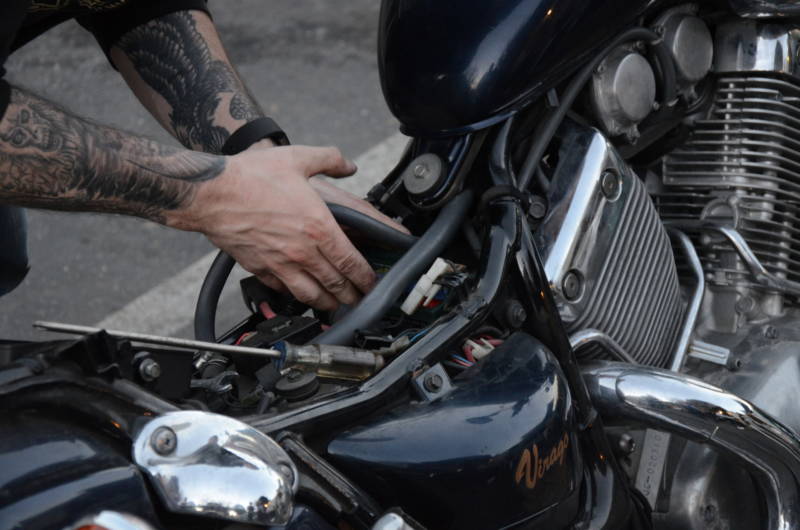
A 2011 study from Brussels — where lane splitting is legal — found that if you replaced 10 percent of cars on the route with motorcycles, it could cut the fourth dimension anybody spends in traffic by xl percent, in part considering of lane splitting.
While safety is frequently used by drivers equally a critique of lane splitting, motorcyclists say it actually makes them experience more than prophylactic while riding. Getting rear-ended while stationary or in motion is an particularly large business organization of motorcyclists.
"We don't like to exist sitting ducks," Miller said. "When we're going faster than the cars, we're in control, and we're monitoring and looking at what'due south happening."
Miller and Starkey besides said motorcycles and motorcyclists can overheat if they are stationary for extended periods of time.
Motorcyclists too argue that drivers' perceptions of lane splitting are skewed because they more than conspicuously recollect the times when a motorcyclists does information technology recklessly, at a high speed, as opposed to when a passenger lane splits responsibly at depression speeds.
"Yous might have ten motorcycles go by that you don't fifty-fifty give a 2d thought," Haris said. "And and so suddenly, either you're not paying attention or someone goes past at a speed that you consider unsafe. And so that stands out in your mind. 'Oh my gosh. That was dangerous.' "
9. Hither's what drivers say
The 2014 study found that 60 pct of drivers disapproved of lane splitting. More than than one-half of those who disapproved said it was because they felt lane splitting was unsafe. Other reasons include fear that it volition lead to a crash, it startles drivers, motorcyclists are going too fast, lane splitting is "unfair" or illegal.
"I recollect it'south rather unsafe," said Edwin Martinez, who commutes to work across the Bay Bridge. "Information technology's unsafe for the person riding the motorbike and as well for the drivers of vehicles."
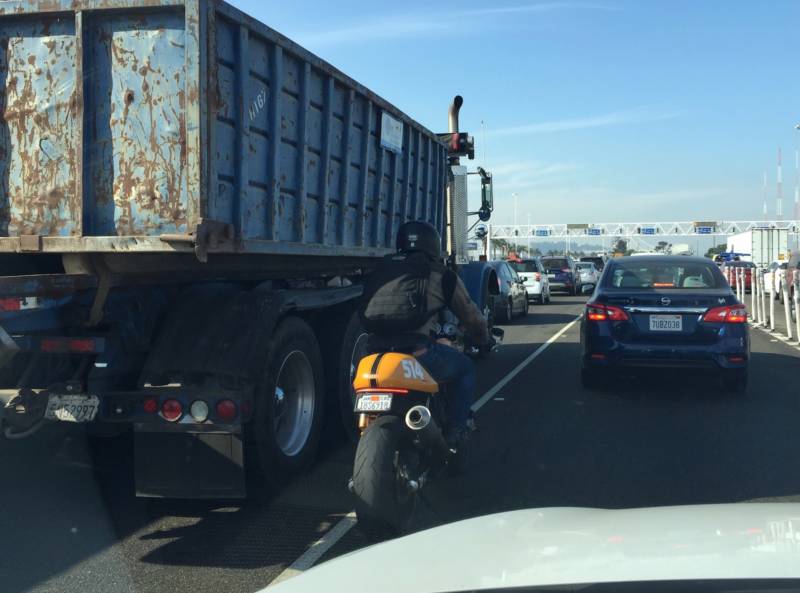
Drivers have also reported motorcyclists intentionally knocking off side mirrors as they lane separate.
"I have been clipped past a motorcycle," said Gaurav Kapur, some other daily Bay Bridge driver, "and they didn't terminate for me. They didn't terminate and expect what damage they did to the car."
Kapur — who used to ride a motorcycle himself — said motorcycles can be hard to encounter when they lane carve up quickly through deadening traffic.
"I love bikes," he said, "but it's just not rubber. Information technology'south highly unpredictable."
10. Lane splitting misunderstandings tin can lead to road rage
If yous search "lane splitting road rage" on YouTube, you'll find lots of videos of lane splitting triggering angry reactions from drivers.
"For me, it resulted in somebody crossing a double yellowish and running me up onto a sidewalk," said Kat Taylor, who has been riding for well-nigh four years. "I ended upwards crashing trying to get abroad from them, and I broke 15 bones, and I got road rash over forty percent of my torso."
Taylor said she no longer discusses lane splitting because of the disagreements it provokes, but other riders said they often take productive conversations about lane splitting.
"I think half the time they recollect it's illegal," Haris said. "So that oftentimes volition change the give-and-take."
Source: https://www.kqed.org/news/11680481/10-things-you-need-to-know-to-understand-lane-splitting-in-california
Post a Comment for "what to do if another motorcycle want to pass while land splitting"